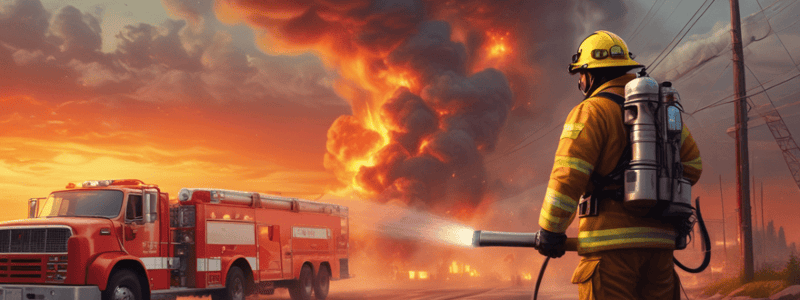Podcast
Questions and Answers
What is the primary reason for the existence of Stack Effect in structures?
What is the primary reason for the existence of Stack Effect in structures?
- There are pressure differences in the atmosphere.
- The structure is not air tight. (correct)
- The structure has windows and doors.
- The temperature difference between inside and outside is 20 degrees Celsius.
When is Stack Effect typically most pronounced?
When is Stack Effect typically most pronounced?
- During hot weather conditions.
- During windy weather conditions.
- During cold weather conditions. (correct)
- During rainy weather conditions.
What contributes to air leaving and entering a structure?
What contributes to air leaving and entering a structure?
- Windows, doors, and ventilation features. (correct)
- The structure's air conditioning system.
- Only doors and windows.
- Only ventilation features.
What can Stack Effect cause in a fire?
What can Stack Effect cause in a fire?
In what type of structures can Stack Effect exist?
In what type of structures can Stack Effect exist?
What can cause wind-driven conditions in a fire, even when there is no wind?
What can cause wind-driven conditions in a fire, even when there is no wind?
What is the primary cause of negative pressure at the bottom of a structure during a fire?
What is the primary cause of negative pressure at the bottom of a structure during a fire?
What term is used to describe smoke moving downwards within a building during the summer?
What term is used to describe smoke moving downwards within a building during the summer?
What is the purpose of installing revolving doors or two separate doors at ground level in High Rise buildings?
What is the purpose of installing revolving doors or two separate doors at ground level in High Rise buildings?
During the winter, what happens to air on the lower floors of a building?
During the winter, what happens to air on the lower floors of a building?
What is the term used to describe the area in a building where the in-flow is equal to the out-flow and air is not moving in either direction?
What is the term used to describe the area in a building where the in-flow is equal to the out-flow and air is not moving in either direction?
What should firefighting crews consider when responding to a structure fire?
What should firefighting crews consider when responding to a structure fire?
Flashcards are hidden until you start studying
Study Notes
Stack Effect
- Stack Effect is the natural movement of air in and out of a structure, which can dramatically affect a fire and its byproducts.
Why Stack Effect Exists
- Structures are not airtight, allowing air to constantly enter and escape through windows, doors, and ventilation features.
- Pressure differences between the atmosphere outside and inside the structure dictate the flow of air.
When and Where Stack Effect Exists
- Stack Effect exists in any structure, from bungalows to high-rise buildings, and is more pronounced in extreme weather conditions.
- The taller the building, the greater the Stack Effect.
- Stack Effect is more pronounced in cold weather due to the large temperature difference between the inside and outside of the structure.
- In cold weather, hot air rises through stairwells, elevator shafts, vents, and cracks, causing a negative pressure at the bottom of the structure.
- In warmer weather, the temperature difference is less drastic, but Stack Effect still exists, with cool air falling within the building and exiting near the bottom.
How Stack Effect Affects Firefighting
- Stack Effect affects the movement of smoke and fire within a building.
- Smoke may move up shafts and hoist-ways and exit the top of the structure naturally in winter, and move down within the structure in summer.
- Reverse Stack Effect occurs when smoke moves downwards within a building.
- Ventilation sectors can utilize Stack Effect to their advantage when removing smoke from a structure.
- A neutral pressure plane, typically near the middle of a building, has equal in-flow and out-flow, with no air movement.
Mitigating Stack Effect
- Engineers use features like revolving doors, separate doors, and walls to separate elevator shafts and stairwells to decrease Stack Effect.
- Firefighters should consider these features to aid in mitigating emergencies.
Summary
- In winter, lower floors suck in air, while upper floors push air out.
- In summer, upper floors suck in air, while lower floors push air out.
- This can present wind-driven fire conditions, even without wind, and disperse smoke and fire byproducts throughout a structure.
Studying That Suits You
Use AI to generate personalized quizzes and flashcards to suit your learning preferences.




